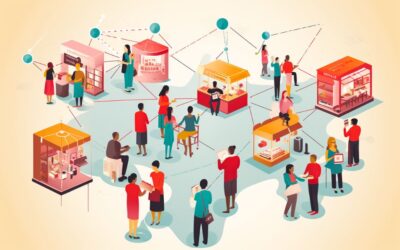What if we could reduce our energy consumption by using digital technology in a responsible way? That’s what the concept of digital sobriety—which companies are talking about more and more—is all about.
Yes, contrary to what we might think, digital technology has a tangible environmental and energy impact. Digital technology alone is responsible for 4% of global greenhouse gas emissions¹ and 2.7% of our total energy consumption.² The Shift Project and ADEME (French Environment and Energy Management Agency) estimate that if we don’t change our ways, these two figures could both double by 2025. That means making digital sobriety transparent—both in the public and private sectors—is crucial to promoting change.
Of course, this isn’t the only issue organizations face. We must also consider well-being at work. As proof, 81% of employees believe that this is a priority issue for companies.
Faced with these figures, a question arises: how can companies combine digital sobriety and well-being at work? In other words, how can they ensure that this sobriety approach doesn’t negatively impact the employee experience? This is what we’ll try to elucidate in this article.
Digital sobriety: what impact does it have on the environment?
Before we delve deeper, let’s set out some definitions.
Digital sobriety is an approach that aims to limit the environmental and energy impact of one’s use of technology, by better managing the equipment and tools we use and the way we use them.
Being digitally sober, then, reduces our digital footprint that comes from the following areas:
- our devices (computers, smartphones, tablets, and TVs)
- our network infrastructure
- and our data centers
In addition to consuming energy, our digital equipment requires many raw materials from all over the planet—some of them extremely rare—which emit greenhouse gases throughout their life cycle (including manufacturing, transportation, distribution, and use). All this increases their environmental impact.
For example, the manufacture of a 4.5-pound computer alone uses nearly a ton of raw materials and generates the equivalent of 275 pounds of CO2 (out of the 372 pounds released during its entire life cycle).³
How we use our equipment can also tip the scales. One glaring example? Sending an email consumes 70 KB and 4 g of CO2 equivalent⁴—the same amount used by NASA to send data to the first astronauts on the Moon!⁵
As a result, ADEME estimates that our equipment (and the uses associated with it) are responsible for almost half of our digital carbon footprint!
Digital Sobriety and well-being at work: two distant concepts?
Companies and employees have a key role to play in reducing the environmental impact of digital technology. However, one may wonder—and rightly so—if being digitally sober can have an impact on the quality of working life (QWL) of employees, i.e. well-being at work.
A mere quick glance at this concept might make us think that promoting digital sobriety means bidding farewell to all our electronic devices forever. Far from it! Several levers can help reduce our digital carbon footprint without impacting well-being .
Indeed, it’s possible to reduce our environmental impact by reducing the equipment and digital tools we use, but also by using them more responsibly.
These different actions can be integrated into a more complete CSR (corporate social responsibility) strategy and contribute to improving the well-being at work of your employees at work. Because more responsible digital use also means rationalizing applications and reducing the slew of emails. For employees, this means less information overload and a smoother work experience on a daily basis.
Also read: Bergamot reduces emails by 95% and boosts productivity with Talkspirit
Finally, implementing a CSR policy can also help attract, retain, and engage more talent and strengthen their sense of belonging to the company. According to a study by Bodet Software and Usine Nouvelle, 61% of employees and HR decision-makers believe that CSR commitment is a lever for employee engagement.
Being digitally sober can therefore have a positive impact on our workplace well-being. But to achieve sobriety, it is also necessary to follow several good practices. We detail them in the section below.
3 best practices to combine digital sobriety with well-being at work
1. Measure your carbon and energy footprint
Before setting up a digital sobriety approach, it is first necessary to look at your current digital uses—especially your carbon and energy impact.
To achieve this, you can use the STERM (Smart Technologies Energy Relevance) model developed by The Shift Project. Available in open access, this model allows you to evaluate the energy relevance of your digital solutions and optimize your technological choices accordingly.
To support your transition to digital sobriety, you can also rely on tools such as:
- Greenspector, a complete suite to measure your digital carbon footprint and improve the sobriety of your mobile and web applications
- Greenly, the all-in-one platform for calculating and reducing your greenhouse gas emissions through integration with all your employees
- Fruggr, the customized and automated solution to establish your carbon strategy
- DC Scope’s Green IT module, which enables you to track your IT department’s carbon footprint
- The Mobile Carbonalyser application (also available as a Firefox extension), which allows you to view your smartphone’s energy consumption
- Scaphandre, an open-source program that measures your computer server’s energy consumption
2. Adopt responsible digital practices
Once you’ve determined your carbon footprint, it’s time to develop strategies to change your digital practices. To this end, you can implement these initiatives and add them to your IT charter:
- Limit the carbon footprint of your IT equipment by keeping it as long as possible, by choosing refurbished devices over new ones, and by recycling all used equipment.
- Reduce the energy consumption of your devices by putting your computer to sleep when you are not using it for a short period of time, by limiting the number of tabs open in your browser, and by regularly sorting your drive.
- Streamline applications by opting more for all-in-one software and eliminating unnecessary and/or redundant applications. If you’re seeking an all-in-one collaborative tool, you can implement Talkspirit. 100% made in France, our solution integrates all the social and collaborative functions you need to work and communicate efficiently: chat and videoconference, groups, project management, news feed, home portal, office suite, a shared calendar, and more.
- Send fewer emails by choosing a collaborative platform that integrates instant messaging (like Talkspirit). And when emails are absolutely necessary, try to limit the number of recipients and the size of attachments (an email with many attachments can generate up to 1.75 ounces of CO2 equivalent).
- Promote remote work and hybrid work (according to ADEME, telecommuting one day a week instead of driving to the office would generate an environmental benefit of 600 fewer pounds of CO2 equivalent per year).
In addition to contributing to the digital sobriety effort, these different actions can also improve workplace and employee well-being. This is for example the case of telecommuting, which would allow employees to benefit from greater flexibility, thus achieving better work-life balance.⁶

3. Raise awareness among employees
As for any change management project, it is of course advisable to accompany your employees in the process by organizing training sessions on digital sobriety. You’ll be able to take advantage of this to better explain:
- what digital sobriety consists of and what its impact on the environment can be. (If you’re looking for informative and fun stats, you can share this infographic on digital pollution with your employees.)
- the importance of participating in this process
- how everyone can help make a difference
- what concrete actions to put in place to reduce wasteful digital practices and their environmental footprint
In order to facilitate the adoption of these good practices, we advise you to rely on ambassadors who’ll accompany your environmental approach by relaying it to all employees, and to involve them in the process. If some of your employees already feel concerned by this issue, do not hesitate to offer them this role!
Finally, why not gamify your sobriety approach in order to boost your employees’ involvement? Quizzes, challenges, contests, point systems, and milestones—there are now a plethora of ways to add fun to your project and ensure that digital sobriety is not seen as just another course module. This is the topic Jane McGonigal, American game designer, addresses in the TedTalks below.
*
* *
To conclude
Digital sobriety and well-being at work are not incompatible: quite the opposite! In fact, the various actions implemented to reduce your digital carbon footprint like the implementation of telecommuting, the rationalization of applications, email reduction, or the gamification of your sobriety approach are also good ways to improve your employees’ well-being at work.
Want to learn more? Contact one of our experts to get more best practices to implement your own digital sobriety approach:
¹ GreenIT’s Global Digital Footprint Study, 2019
² Lean ICT’s report on digital sobriety, The Shift Project, 2018
³ ADEME’s report on “The dark side of digital technology”, 2019
⁴ “How Bad are Bananas?: The Carbon Footprint of Everything,” Mike Berners-Lee, 2010
⁵ “Hail to digital sobriety!” video, Frederic Bordage
⁶ Cisco study on hybrid work, 2022



